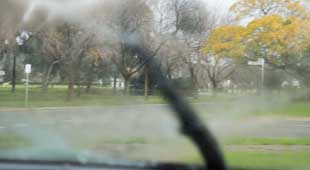The Driver's Handbook
Driving at Night or in Poor Visibility

When driving between sunset and sunrise or in hazardous weather conditions, when rain, dust or fog cause reduced or poor visibility, your vehicle's headlights, rear lights and number plate light must be turned on. It is an offence to drive a vehicle displaying only parking lights during these times.
Visibility can be said to be poor any time when, owing to insufficient daylight or unfavourable conditions, people or vehicles on a road are not clearly visible at a distance of about 100 metres to a person of normal vision.
Pedestrians and bicycles are sometimes hard to see at night and in bad weather. Watch carefully for them.
When driving at night or in poor visibility

- Your driving speed at night should be adjusted to the range of your headlights. Drive so that you can stop well within the distance you can see to be clear ahead.
- Do not look directly at oncoming headlights. You may be dazzled. Look at the left hand side of the road and drive well to the left. If you are dazzled, slow down. If you cannot see, stop.
- You can momentarily flash your headlights on high beam to indicate to another driver that you intend to overtake.
- Keep your windscreen and lights clean.
- Always dip your lights within 200 metres both when an oncoming vehicle is approaching you and when you are approaching the rear of another vehicle. It is an offence to use your lights in such a way that you dazzle other road users.
- Front or rear fog lights can also be used in fog or other hazardous weather conditions causing reduced visibility - but you must switch them off when visibility improves.
- To reduce the effect of being dazzled by the headlights of on-coming vehicles at night, before starting your journey, thoroughly clean your windscreen inside and outside of insects and dust. Regularly clean your windscreen and lights throughout your journey (usually at refuelling or rest stops).
Hazard warning lights
You must not use your hazard warning lights unless your vehicle is stopped or going slowly and causing an obstruction, or is stopped in an emergency lane.
Hazard warning lights can be used by drivers:
- in hazardous weather conditions
- as part of an anti-theft device
- if you are stopping to sell a product (such as ice-creams)
- by the driver of a school bus when picking up or setting down passengers.
Warning device (horn)
You must sound your warning device only to warn others of danger. You must not use your warning device to create unnecessary or offensive noise. Musical warning devices are not permitted.
Parking at night or in poor visibility
If you leave your vehicle on the road at night or when visibility is poor, it must have front and rear parking lights alight unless it is made clearly visible from a distance of 200 metres by a lighted street light or other lamp.
If your vehicle is 2.2 metres wide or wider, you must always have the clearance and side marker lights alight at night or in poor visibility.
Rear vision mirrors
Your vehicle must have a mirror or mirrors fitted so that you can have a clear view of any vehicle approaching from behind. If, for any reason, your view from an internally-fitted mirror is obscured, external mirrors must be fitted that provide a clear view.
Panel vans and utilities must be fitted with two external rear vision mirrors. At least one mirror must be fitted to each side of any vehicle when towing a trailer that is wider than the towing vehicle. Motorcycles built after (June 1975) must also have a rear vision mirror on each side.
Check list
Your vehicle needs to be fitted with:
- lights - headlights, tail lights, number plate light, parking lights
- horn
- mirrors - an internal rear view mirror, and if this does not offer a clear view, side mounted rear view mirrors.
This equipment must be kept functional and clean.































